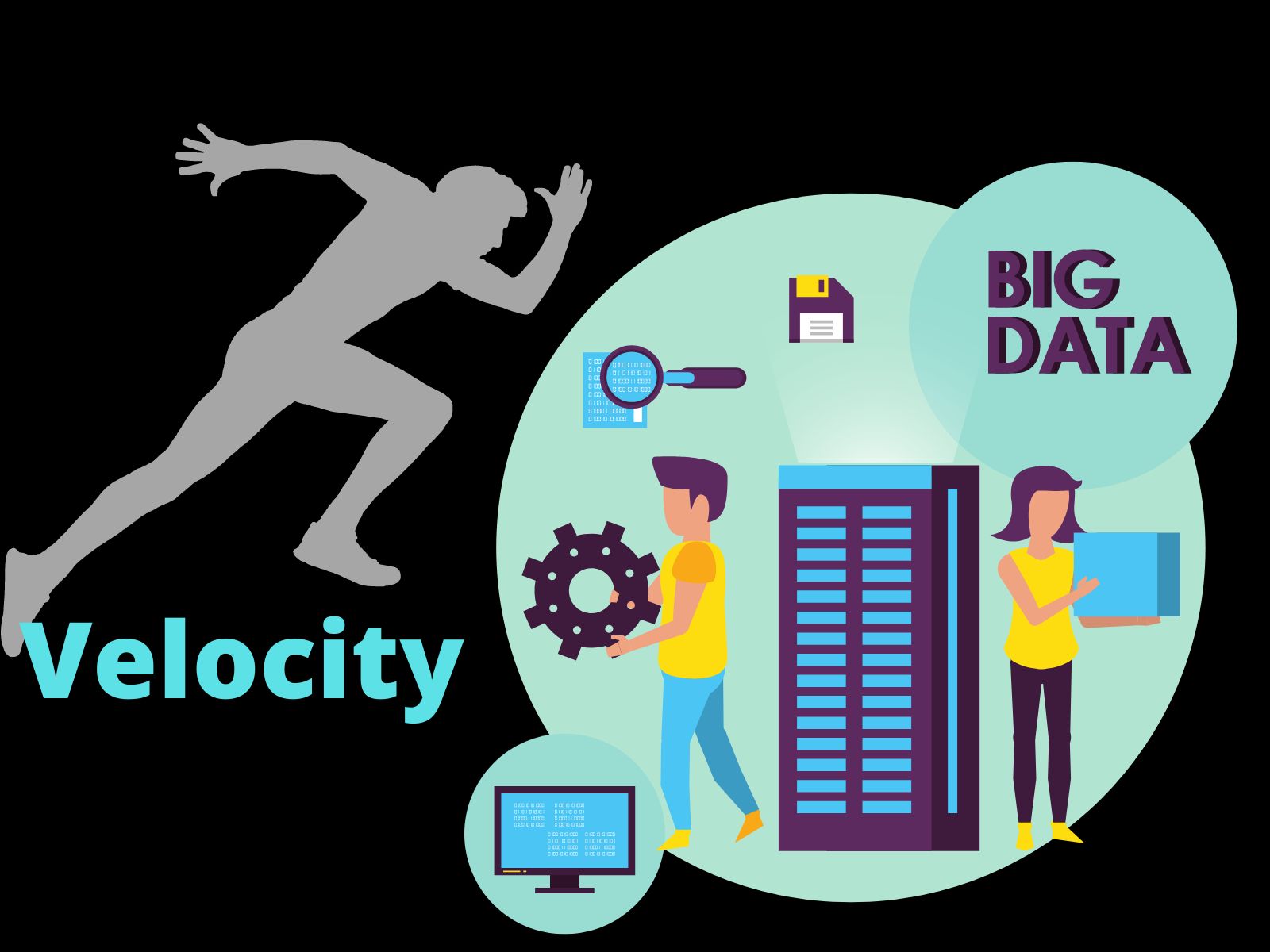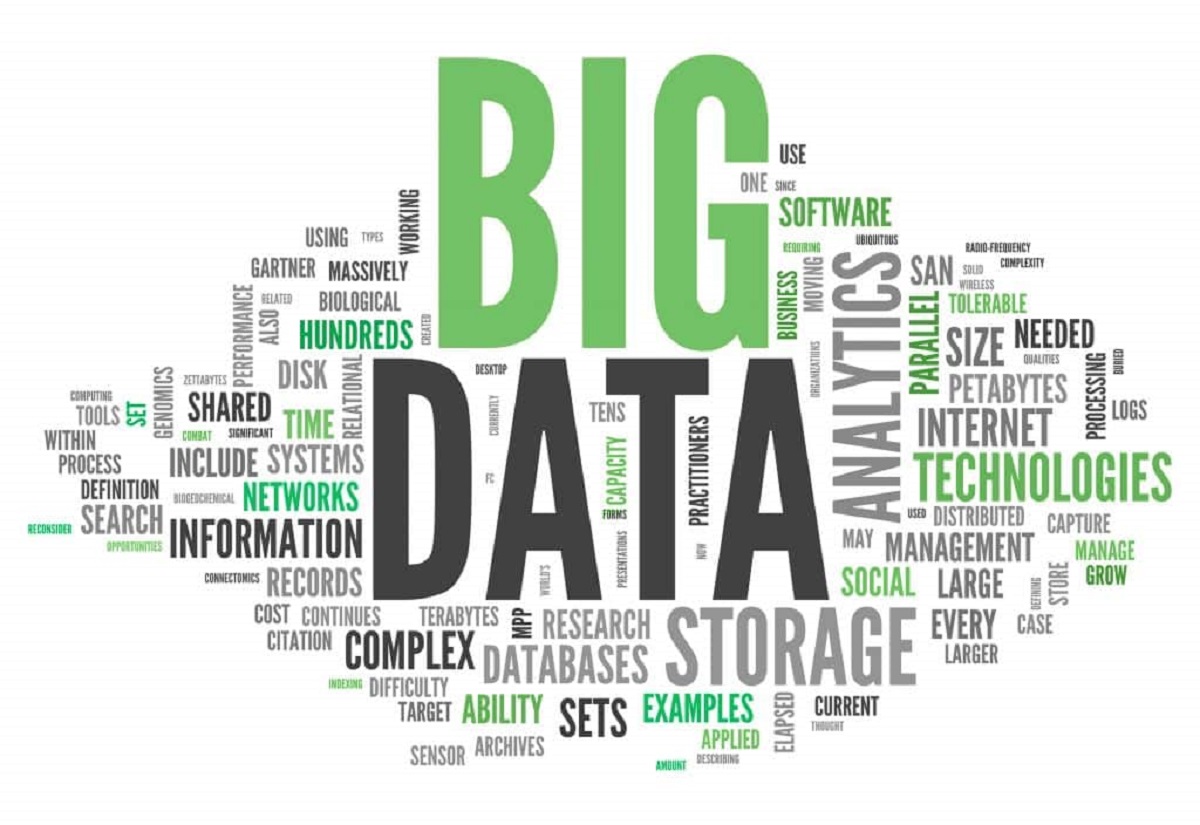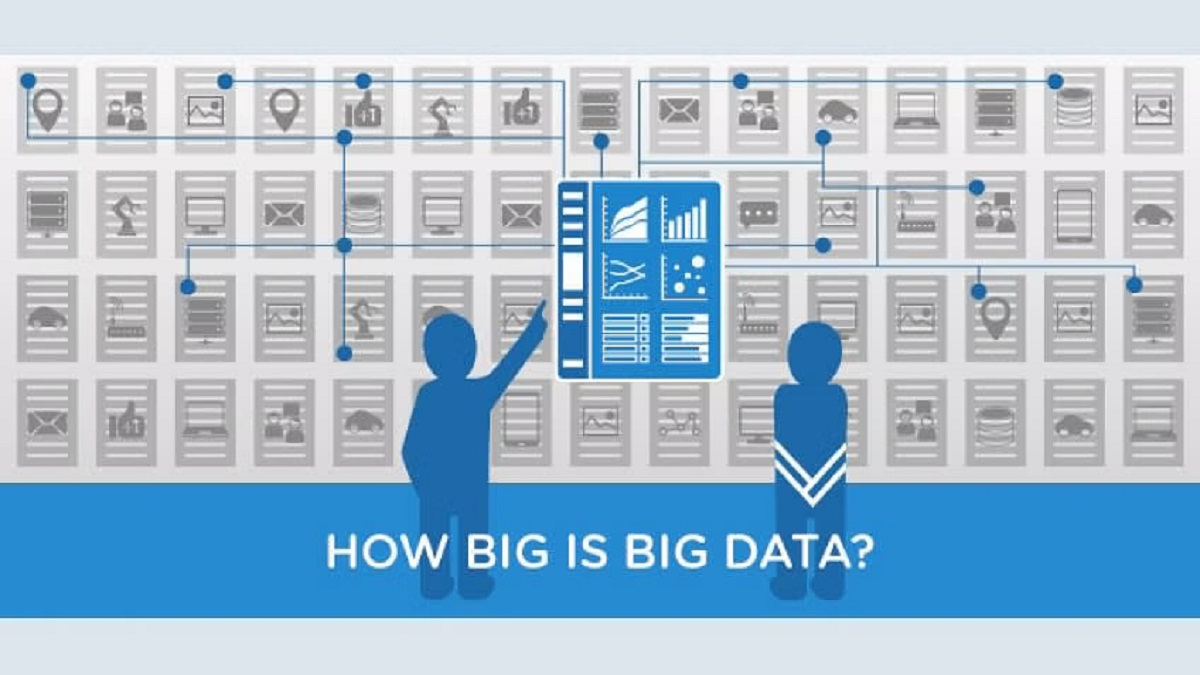Introduction
Welcome to the world of big data! In this era of technological advancements, we are constantly generating vast amounts of data from various sources such as social media, online transactions, sensors, and more. This enormous volume of data, known as big data, has the potential to provide valuable insights and drive informed decision-making.
When we talk about big data, we often hear terms like volume, variety, and velocity. These three V’s of big data describe the characteristics that make this data different from traditional data sources. In this article, we will focus on one of these key characteristics — velocity.
Velocity refers to the speed at which data is being generated, collected, and processed. With the advent of the internet and smart devices, data is being created and captured at an unprecedented rate. Every click, swipe, like, and share is contributing to the ever-growing pool of data, and it is essential to be able to extract meaningful insights from this data in real-time.
Velocity plays a crucial role in big data analytics as it enables organizations to process and analyze data in near real-time, allowing for quicker and more informed decision-making. With the increasing demand for real-time insights, businesses across various industries are leveraging the power of velocity to gain a competitive edge.
In this article, we will explore the importance of velocity in big data, its role in real-time data processing, the concept of streaming data, and examples of how velocity is being utilized in different domains. Additionally, we will also discuss the challenges and considerations associated with velocity in big data.
Definition of Big Data
In order to understand the concept of velocity in big data, it is important to first define what big data actually is. Big data refers to extremely large and complex data sets that cannot be easily processed and analyzed through traditional methods.
One of the key characteristics of big data is its volume. The sheer amount of data being generated and collected is immense, thanks to advancements in technology and the widespread use of digital devices. This includes data from social media platforms, online transactions, IoT devices, sensors, and more. The volume of data continues to grow exponentially, and it is estimated that the amount of data generated worldwide will reach 175 zettabytes by 2025.
Another characteristic of big data is its variety. It encompasses structured, unstructured, and semi-structured data. Structured data refers to information that is organized and stored in a fixed format, such as a relational database. On the other hand, unstructured data refers to data that does not have a predefined structure, such as text documents, images, videos, and audio files. Semi-structured data lies somewhere in between, with some organization or tags attached to it.
Lastly, big data is characterized by velocity, which we will delve deeper into in this article. Velocity relates to the speed at which data is being generated, captured, and processed. With the rise of real-time data sources like social media, sensors, and mobile devices, the velocity of data has increased exponentially. This means that data is being created and collected at an unprecedented rate, which poses both challenges and opportunities for businesses and organizations.
Overall, big data encompasses the vast volume, variety, and velocity of data that is generated and collected in our digital world. The ability to effectively harness and analyze this data provides valuable insights, enables informed decision-making, and drives innovation across various industries.
Definition of Velocity in Big Data
Velocity in the context of big data refers to the speed at which data is being generated, captured, and processed. It focuses on the real-time aspect of data, where organizations need to handle and analyze information as it is being produced.
In traditional data processing, data is collected, stored, and analyzed after it has been generated. However, with the increasing reliance on real-time insights, the velocity of data has become a crucial factor in big data analytics. It requires organizations to process and analyze data as quickly as possible to gain valuable insights and make informed decisions.
The velocity of data is influenced by various factors such as the speed of data generation, data transmission, and data processing. These factors determine how quickly data moves through the system and can be analyzed for meaningful insights.
Real-time data processing is a fundamental aspect of velocity in big data. It involves continuously processing and analyzing data as it is generated, allowing organizations to respond promptly to changing situations and make data-driven decisions in real-time. Real-time data processing requires efficient data capture, storage, and analysis infrastructure to handle the high volume and velocity of data.
Another aspect of velocity in big data is the concept of streaming data. Streaming data refers to a continuous flow of data that is processed and analyzed in real-time. Unlike batch processing, where data is collected over a period of time and then processed together, streaming data allows for immediate analysis and action as data flows in.
With streaming data, organizations can monitor and extract insights from data streams as they occur, enabling them to react quickly to emerging trends, anomalies, or events. This is especially valuable in industries such as finance, e-commerce, logistics, and social media, where real-time information is crucial for decision-making.
Overall, velocity in big data emphasizes the need to process and analyze data in real-time to gain timely insights and make informed decisions. Real-time data processing and streaming data are key components of velocity, enabling organizations to handle the high speed at which data is generated and extract valuable insights in a timely manner.
The Importance of Velocity in Big Data
Velocity plays a crucial role in big data analytics as it enables organizations to process and analyze data in near real-time, allowing for quicker and more informed decision-making. The importance of velocity in big data can be understood through the following key aspects:
Real-time Insights: With the increasing demand for real-time insights, the velocity of data becomes vital. Organizations can capture and analyze data as it is being generated, allowing them to identify patterns, trends, and anomalies in real-time. This empowers businesses to make immediate decisions and take prompt action based on up-to-date information, leading to enhanced operational efficiency and competitive advantage.
Improved Decision-Making: Velocity in big data enables organizations to respond quickly to changing market conditions, customer preferences, and emerging trends. By analyzing data in real-time, decision-makers can have a comprehensive and current understanding of the business landscape, enabling them to make informed decisions with confidence. This agility in decision-making can translate into better customer experiences, optimized processes, and increased revenue.
Identifying Opportunities and Risks: The high velocity of data allows organizations to identify opportunities and risks as they happen. By monitoring data streams in real-time, businesses can detect market trends, customer behavior, and competitor activities in a timely manner. This enables proactive decision-making, allowing organizations to seize opportunities, mitigate risks, and stay ahead of the competition.
Enhanced Personalization: Velocity in big data facilitates personalized experiences for customers. By analyzing data in real-time, businesses can gather insights about customer preferences, behavior, and needs. This enables organizations to deliver personalized recommendations, offers, and content, creating a more engaging and tailored customer experience. Increased personalization can lead to higher customer satisfaction, loyalty, and increased revenue.
Operational Efficiency: Real-time data processing and analysis can enhance operational efficiency in various ways. By monitoring and analyzing data streams, organizations can identify bottlenecks, inefficiencies, and operational issues as they occur. This enables timely intervention and corrective actions, leading to improved processes, reduced costs, and enhanced productivity.
Overall, the importance of velocity in big data lies in its ability to provide real-time insights, drive informed decision-making, identify opportunities and risks, personalize experiences, and enhance operational efficiency. By harnessing the velocity of data, organizations can gain a competitive edge in today’s fast-paced and data-driven business landscape.
Real-Time Data Processing
Real-time data processing is a fundamental aspect of velocity in big data. It involves the continuous processing and analysis of data as it is generated, allowing organizations to respond promptly to changing situations and make data-driven decisions in real-time.
Traditional data processing methods often involve batch processing, where data is collected over a period of time and then processed together. This approach is suitable for certain scenarios, but it lacks the ability to handle real-time data streams and provide immediate insights.
Real-time data processing, on the other hand, allows organizations to capture, process, and analyze data as it is produced, enabling timely decision-making. It involves the following key steps:
- Data Capture: Real-time data processing begins with capturing data from various sources, such as sensors, IoT devices, social media platforms, web logs, and more. This data is collected continuously and sent to a processing system for analysis.
- Data Validation and Cleaning: Once the data is captured, it goes through a validation and cleaning process to ensure its accuracy and consistency. This step involves removing duplicates, handling missing values, and applying data quality checks.
- Data Transformation: After validation and cleaning, the data is transformed into a suitable format for analysis. This may involve aggregating data, transforming data types, and applying necessary calculations or filters.
- Data Analysis: Once the data is transformed, it is ready for analysis. Various techniques and algorithms can be applied to gain insights and extract meaningful patterns from the data. This analysis can range from simple statistical calculations to complex machine learning algorithms.
- Real-Time Visualization and Action: The insights derived from the real-time data analysis can be visualized through dashboards, charts, graphs, and other visual representations. This allows decision-makers to have a clear understanding of the current state of affairs and take immediate action based on the real-time insights.
Real-time data processing is utilized in various industries and applications. For example, in finance, real-time processing enables the detection of fraud or anomalies in financial transactions as they occur, minimizing financial losses. In manufacturing, real-time data analysis enables proactive maintenance and quality control, reducing downtime and improving product quality.
Overall, real-time data processing is a critical component of velocity in big data. It empowers organizations to capture, analyze, and act upon data as it is generated, enabling them to make timely and informed decisions in response to changing market conditions, customer needs, and emerging trends.
Streaming Data
Streaming data is an integral part of velocity in big data. It refers to a continuous flow of data that is processed and analyzed in real-time, allowing organizations to gain immediate insights and take timely actions.
Unlike batch processing, where data is collected over a period of time and then processed together, streaming data involves the analysis of data as it flows in. This continuous flow of data is particularly important in applications where real-time information is crucial for decision-making.
The concept of streaming data can be understood through the following key aspects:
- Data Ingestion: Streaming data begins with the ingestion of data from various sources. These sources can include sensors, social media platforms, mobile devices, web logs, and more. The data is continuously ingested into a processing system, enabling real-time analysis.
- Data Processing: As the streaming data is ingested, it goes through a series of processing steps. This includes validation, cleaning, transformation, and analysis of data. These processing steps are performed in real-time, allowing organizations to gain insights and make decisions as the data is received.
- Real-Time Analysis: Streaming data allows for immediate analysis of events and patterns as they occur. Organizations can apply various analytical techniques and algorithms to the streaming data to derive real-time insights. This can include anomaly detection, trend analysis, pattern recognition, and predictive modeling.
- Continuous Feedback Loop: With streaming data, organizations can continuously receive feedback and insights based on the real-time analysis. This information can be used to adjust and optimize business processes, improve customer experiences, and respond quickly to changing circumstances.
- Actionable Insights: Streaming data analysis provides organizations with actionable insights that can be acted upon in real-time. For example, it can trigger automated responses, alerts, or notifications based on predefined rules or thresholds. This enables organizations to make immediate decisions or take corrective actions as required.
Streaming data has numerous applications across different industries. For instance, in the transportation sector, streaming data from traffic sensors and GPS devices can be analyzed in real-time to optimize route planning, reduce congestion, and improve traffic flow. In e-commerce, streaming data analysis can be used to offer personalized product recommendations to customers in real-time, increasing engagement and conversion rates.
By leveraging streaming data, organizations can gain a competitive advantage by making real-time decisions based on the most up-to-date information. The ability to process and analyze data as it flows in enhances the agility, responsiveness, and efficiency of business operations.
Examples of Velocity in Big Data
Velocity, as one of the key characteristics of big data, plays a significant role in various industries and applications. Here are some examples that showcase how velocity is utilized in big data:
Social Media Analytics: Social media platforms generate an immense volume of data in real-time through user interactions, posts, comments, likes, and shares. Organizations harness the velocity of this data to gain insights into customer sentiment, trends, and preferences. By analyzing social media data in real-time, companies can understand public opinion, monitor brand reputation, and respond promptly to customer feedback.
Financial Services: In the financial industry, real-time data processing and analysis are crucial for fraud detection, risk management, and high-frequency trading. Rapid analysis of market data, news feeds, and transactional data allows financial institutions to identify anomalies, suspicious patterns, and potential risks in real-time. This enables timely intervention and decision-making to mitigate financial losses and maintain market competitiveness.
Supply Chain Management: Velocity in big data is vital for optimizing supply chain operations. Real-time analysis of data from sensors, IoT devices, and logistics systems allows organizations to track inventory levels, monitor shipment statuses, and dynamically adjust logistics routes. By analyzing this data in real-time, companies can improve order fulfillment, reduce delivery times, and enhance overall supply chain efficiency.
Smart Cities: With the increasing adoption of smart city technologies, velocity in big data plays a crucial role in improving urban planning and resource allocation. Real-time analysis of data from various sources, such as traffic sensors, weather stations, and energy grids, enables cities to optimize traffic flow, detect and respond to emergencies, and enhance energy efficiency. By harnessing the velocity of data, cities can create smarter and more sustainable environments for their residents.
Healthcare: Real-time data processing is of utmost importance in healthcare for patient monitoring, disease surveillance, and personalized medicine. By analyzing streaming data from wearable devices, electronic health records, and medical sensors, healthcare providers can identify potential health risks, track patient conditions, and intervene in a timely manner. This enables proactive healthcare interventions, better patient outcomes, and improved operational efficiency.
Online Retail: E-commerce companies rely on velocity in big data to personalize customer experiences and optimize sales. Real-time analysis of customer browsing behavior, purchase history, and market trends allows for dynamic pricing, targeted marketing campaigns, and personalized product recommendations. By leveraging the velocity of data, online retailers can provide a seamless and customized shopping experience, ultimately increasing conversions and customer satisfaction.
These examples demonstrate how velocity in big data is leveraged across various industries to gain real-time insights, make informed decisions, and enhance operational efficiency. By effectively harnessing the speed at which data is generated, organizations can unlock the potential of big data and gain a competitive advantage in today’s data-driven world.
Challenges and Considerations of Velocity in Big Data
While velocity in big data provides organizations with tremendous opportunities, it also presents several challenges and considerations that need to be addressed. Here are some of the key challenges and considerations associated with velocity in big data:
Data Volume and Variety: The fast pace at which data is generated can lead to enormous volumes of data that need to be processed and analyzed in real-time. Additionally, the variety of data sources and formats adds complexity to the analysis process. Handling and integrating diverse data types and formats require robust data processing infrastructure and effective data integration strategies.
Data Quality and Accuracy: Real-time data processing may result in the ingestion of data that is incomplete, erroneous, or of poor quality. Organizations need to implement data validation and cleansing techniques to ensure the accuracy and reliability of the streaming data. Data quality issues can impact the validity and reliability of the insights derived, leading to incorrect decision-making.
Infrastructure and Scalability: Real-time data processing requires a robust and scalable infrastructure capable of handling high-velocity data streams. Organizations need to invest in appropriate hardware, software, and network resources to support the velocity of data. Scalable architectures and cloud-based solutions can help address the challenges of processing and analyzing large volumes of streaming data.
Latency and Responsiveness: Real-time data analysis is highly dependent on low latency to ensure timely insights and actions. Delays in data processing and analysis can significantly impact decision-making, especially in time-sensitive applications such as financial trading or emergency response systems. Organizations must optimize their data processing pipelines and reduce latency to meet the requirements of real-time analytics.
Data Privacy and Security: The velocity of data introduces additional challenges in ensuring data privacy and security. Organizations need to implement robust encryption, access controls, and data governance policies to protect streaming data. The real-time nature of data processing also requires proactive monitoring for potential security breaches and timely detection and response to any incidents.
Talent and Expertise: The field of real-time data processing and analysis requires skilled professionals who are proficient in handling high-velocity data streams and implementing real-time analytics techniques. Organizations need to invest in training and development programs to build a team with the necessary expertise in handling and extracting insights from streaming data.
It is also important to consider ethical and legal considerations when working with streaming data. Organizations must comply with data protection laws and ensure that proper consent is obtained for the collection and analysis of real-time data. Respect for user privacy and responsible data usage should be priorities in all aspects of velocity in big data.
Overall, addressing the challenges and considerations associated with velocity in big data requires a comprehensive approach that involves robust infrastructure, data quality management, low-latency processing, security measures, talent acquisition, and ethical considerations. By proactively managing these challenges, organizations can harness the full potential of velocity in big data and unlock valuable insights for informed decision-making.
Conclusion
Velocity is a critical aspect of big data that focuses on the speed at which data is generated, captured, and processed. The increasing volume and variety of data, coupled with the need for real-time insights, have propelled the importance of velocity in big data analytics.
In this article, we explored the definition of big data and the role of velocity within it. We discussed the significance of velocity in enabling real-time insights, improving decision-making, identifying opportunities and risks, enhancing personalization, and optimizing operational efficiency.
Real-time data processing and streaming data were highlighted as key components of velocity. We examined how organizations leverage real-time data processing to gain insights as data is generated, captured, and analyzed. We also explored the concept of streaming data, which allows for the continuous analysis of data in real-time, enabling immediate actions and interventions based on up-to-date information.
We provided examples of how velocity is applied in various industries, such as social media analytics, finance, supply chain management, smart cities, healthcare, and online retail. These examples demonstrated the significant impact that velocity in big data can have on driving business success and improving operational efficiency.
However, it is essential to acknowledge the challenges and considerations associated with velocity in big data. These challenges include managing large data volumes, ensuring data quality and accuracy, addressing infrastructure and scalability requirements, reducing latency, ensuring data privacy and security, and attracting talent with the necessary expertise.
In conclusion, velocity in big data plays a vital role in today’s fast-paced, data-driven world. By effectively managing the speed at which data is generated and applying real-time data processing techniques, organizations can gain actionable insights, make informed decisions, and stay ahead of the competition. Velocity empowers businesses to harness the full potential of big data and drive innovation in various industries, ultimately leading to improved customer experiences, operational efficiency, and business success.

























